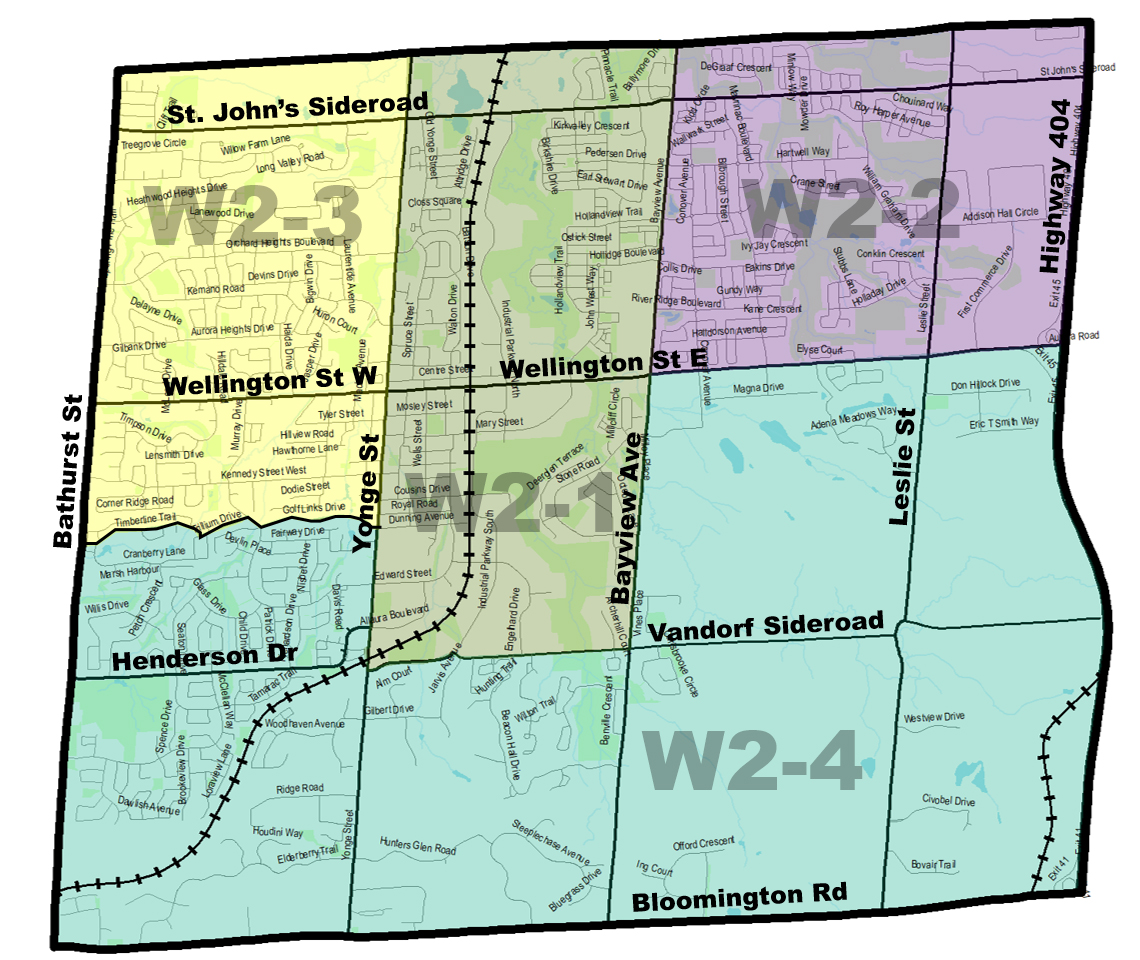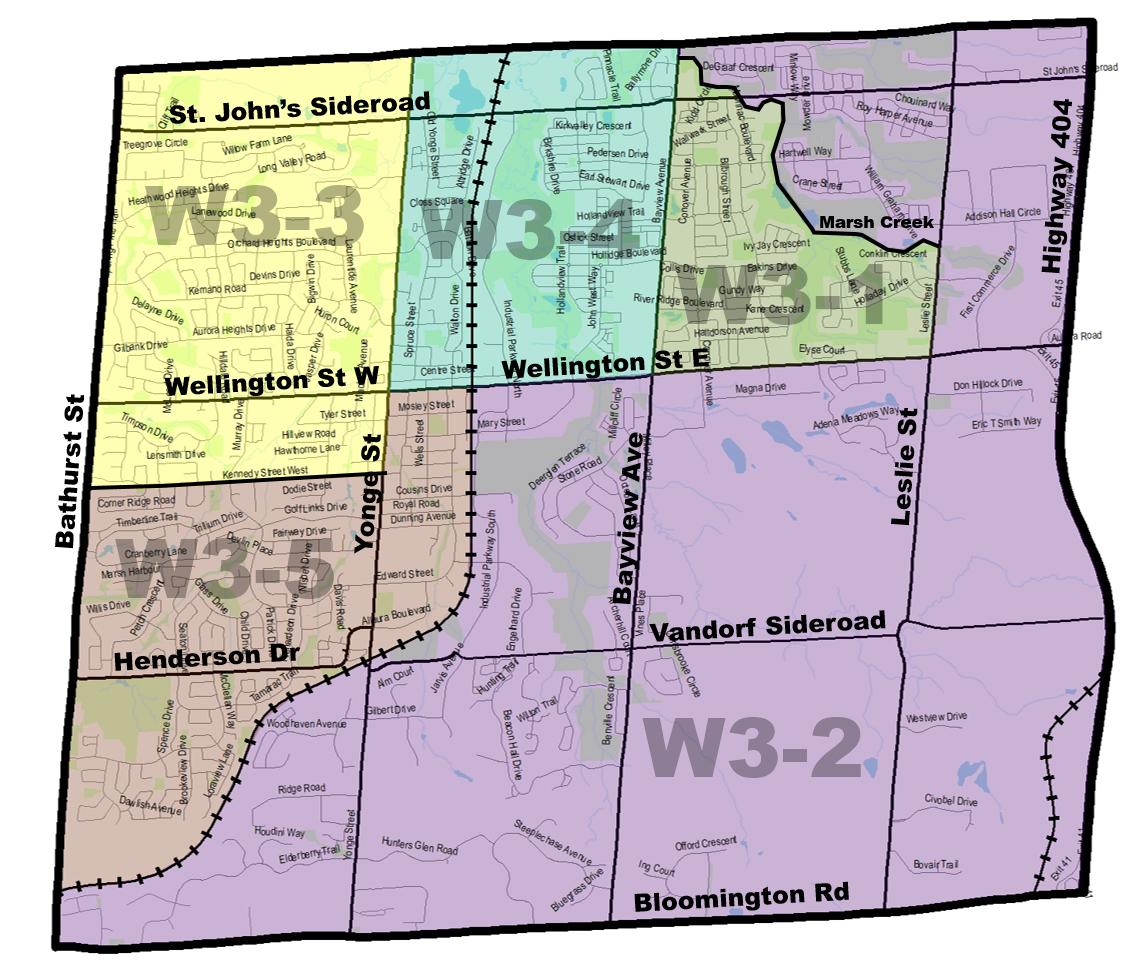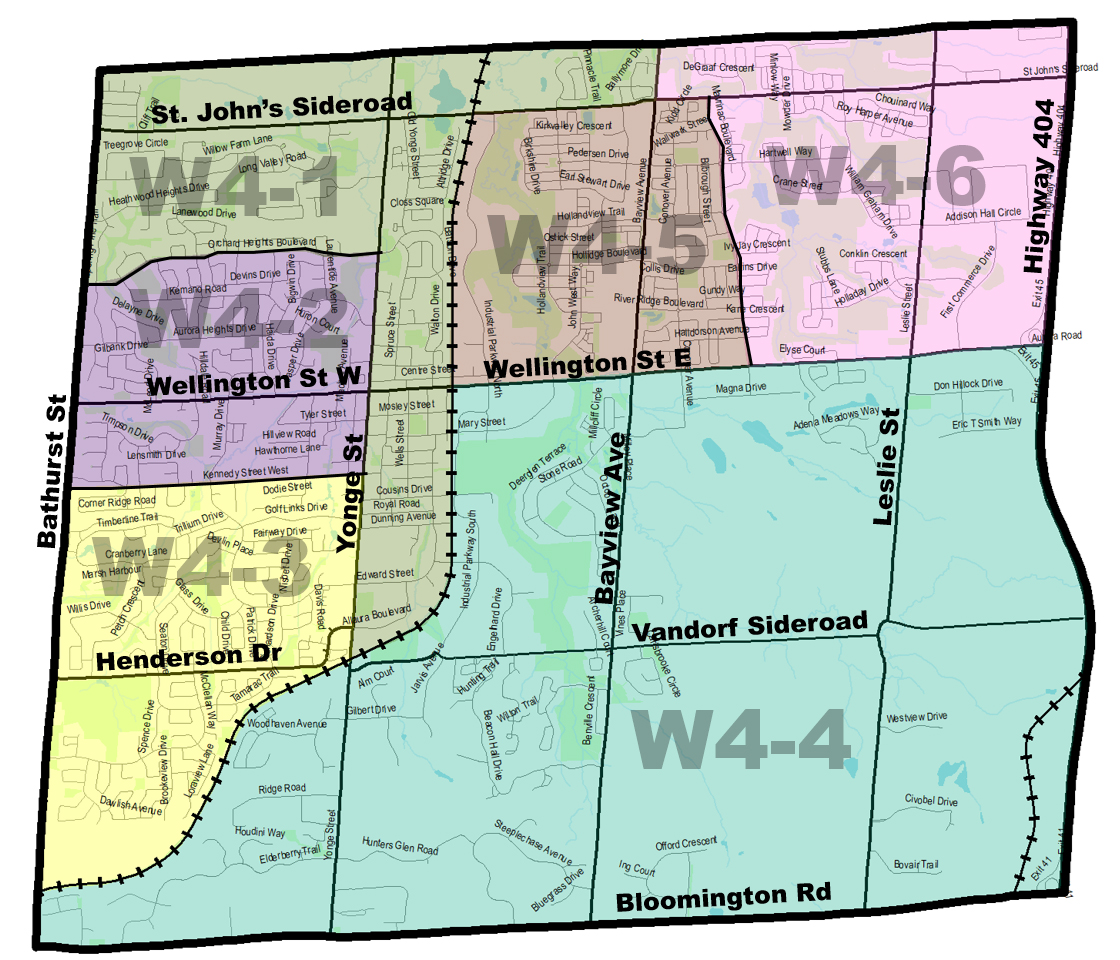Rounds 1 and 2 of the project's public engagement are complete. A Final Report with a recommendation for a ward system for Aurora is anticipated in Spring 2020.
Aurora Electoral System Review
Aurora Town Council has passed a motion directing staff to investigate a ward system for Aurora. An independent team of consultants is carrying out the Aurora Electoral System Review (Aurora ESR).
Following the first round of public engagement (Round 1), the Aurora ESR has developed 4 options for a ward structure for Aurora. All Options achieve effective representation, although there is a difference in how well each achieves the various components of effective representation.
The Aurora ESR Options Report and Executive Summary are now available.
Round 2 of the project's public engagement requested feedback on the Options from stakeholders, Members of Council and the general public. This feedback is being collated and will be provided in a final report.
A final report with a recommendation for a ward system was considered by Council, and a by-law to establish Wards in Aurora for the 2022 Election was passed on July 14, 2020. More information can be found on the Establishment of a Ward System webpage.
Option 1: 3 Wards

| Town of Aurora - Ward Boundary Options Forecast Census Population at Election Year |
Population 2022 | Variance from average | Population 2026 | Variance from average | Population 2030 | Variance from average | Population 2034 | Variance from average |
|---|---|---|---|---|---|---|---|---|
| W1-1 | 23,540 | 11.0% | 25,520 | 12.6% | 27,100 | 13.9% | 28,240 | 14.6% |
| W1-2 | 20,430 | -3.6% | 21,680 | -4.3% | 22,680 | -4.7% | 23,380 | -5.1% |
| W1-3 | 19,640 | -7.4% | 20,780 | -8.3% | 21,630 | -9.1% | 22,290 | -9.5% |
| Average Ward Population | 21,200 | 22,660 | 23,800 | 24,640 |
Option 1 contains 3 wards. The average 2026 ward population is 22,660. Ward populations in this Option range from 20,780 to 25,520 with a variance from the average of -8% to +12.6%., well within the appropriate range for voter parity.
Option 1 also keeps communities together (a map of Aurora Neighbourhood Associations can be found in Appendix A to the Options Report). In addition to major roads like Yonge, Wellington and Bayview, and the railway tracks, this Options also uses neighbourhood streets like Kennedy Street West and Murray Drive as ward boundaries.
Implications for Council composition
In the 3 Ward Option there would have to be more than one councillor per ward to meet the Municipal Act requirement of a minimum council size of five members, including the Mayor. Electing two Councillors per ward would be the most direct way of implementing Option 1. The result would be a Council of seven members. A Deputy Mayor would have to be elected by Council or appointed by the Mayor.
Another approach would be to reduce Council size to five members. In this configuration, there would be one Councillor per ward plus a Mayor and Deputy Mayor elected at-large.
Option 2: 4 Wards

| Town of Aurora - Ward Boundary Options Forecast Census Population at Election Years |
||||||||
| OPTION 2 | Population 2022 | Variance from average | Population 2026 | Variance from average | Population 2030 | Variance from average | Population 2034 | Variance from average |
| W2-1 | 15,960 | 0.4% | 16,510 | -2.9% | 16,940 | -5.1% | 17,250 | -6.7% |
| W2-2 | 15,990 | 0.6% | 17,840 | 4.9% | 19,310 | 8.2% | 20,380 | 10.3% |
| W2-3 | 14,640 | -7.9% | 15,500 | -8.8% | 16,140 | -9.6% | 16,640 | -10.0% |
| W2-4 | 17,020 | 7.0% | 18,130 | 6.6% | 19,020 | 6.6% | 19,640 | 6.3% |
| Average Ward Population | 15,900 | 17,000 | 17,850 | 18,480 |
Option 2 contains 4 wards. The average 2026 ward population is 17,000. Ward populations in this Option range from 15,500 to 18,130 with a variance from the average of -8.8% to + 6.6%. This voter parity range is excellent.
Option 2 also uses major roads like Yonge, Wellington, Bayview and Vandorf Sideroad as ward boundaries. Most communities are kept together (see Appendix A of the Options Report). However, to achieve voter parity, the northern part of the Highland Gate community had to be split off by drawing the southern boundary of W2-3 along Timberline Trail/Trillium Drive and Golf Links Drive. Also, the railway tracks are not a ward boundary in Option 2 but are contained in W2-1 and W2-4 respectively.
Implications for Council composition
This Option would lead to a Council of five members, four Ward Councillors plus the Mayor. A Deputy Mayor would have to be elected by Council or appointed by the Mayor. If a slightly larger Council was desirable, a Deputy Mayor could be elected at-large for a Council of six members.
Option 3: 5 Wards

| Town of Aurora - Ward Boundary Options Forecast Census Population at Election Years |
||||||||
| OPTION 3 | Population 2022 | Variance from average | Population 2026 | Variance from average | Population 2030 | Variance from average | Population 2034 | Variance from average |
| W3-1 | 11,390 | -10.5% | 12,720 | -6.5% | 13,770 | -3.6% | 14,540 | -1.6% |
| W3-2 | 13,360 | 5.0% | 14,800 | 8.8% | 15,940 | 11.6% | 16,730 | 13.2% |
| W3-3 | 14,040 | 10.4% | 14,880 | 9.4% | 15,520 | 8.7% | 16,010 | 8.3% |
| W3-4 | 11,610 | -8.7% | 12,030 | -11.5% | 12,350 | -13.5% | 12,590 | -14.8% |
| W3-5 | 13,210 | 3.9% | 13,550 | -0.4% | 13,830 | -3.2% | 14,040 | -5.0% |
| Average Ward Population | 12,720 | 13,600 | 14,280 | 14,780 |
Option 3 contains 5 wards. The average 2026 ward population is 13,600. Ward populations in this Option range from 12,030 to 14,880 with a variance from the average of -11.5% to +9.4%. The 5 Ward Option's voter parity range is entirely appropriate.
Option 3 keeps communities together (see Appendix A of the Options Report). This Option also uses major roads like Yonge, Wellington and Bayview as ward boundaries. Kennedy Street West, a neighbourhood street, is also a boundary. In order to balance ward populations, W3-1 had to be carved out of the north-east quadrant of Aurora. In addition to easily recognizable boundaries like Bayview, Wellington and Leslie, its north-eastern boundary is Marsh Creek. In this Option the railway tracks are a ward boundary south of Wellington.
Implications for Council composition
This Option would lead to a Council of 6 members, five Ward Councillors plus the Mayor. A Deputy Mayor would have to be elected by Council or appointed by the Mayor. If a Council size similar to the current Council was desirable, a Deputy Mayor could be elected at-large for a Council of seven members.
Option 4: 6 Wards

| Town of Aurora - Ward Boundary Options Forecast Census Population at Election Years |
||||||||
| OPTION 4 | Population 2022 | Variance | Population 2026 | Variance | Population 2030 | Variance | Population 2034 | Variance |
| W4-1 | 10,155 | -4.2% | 10,595 | -6.5% | 10,935 | -8.1% | 11,185 | -9.2% |
| W4-2 | 10,785 | 1.7% | 11,545 | 1.9% | 12,115 | 1.8% | 12,555 | 1.9% |
| W4-3 | 11,660 | 10.0% | 12,000 | 5.9% | 12,280 | 3.2% | 12,490 | 1.4% |
| W4-4 | 8,780 | -17.2% | 9,690 | -14.5% | 10,400 | -12.6% | 10,890 | -11.6% |
| W4-5 | 11,740 | 10.8% | 12,440 | 9.8% | 13,000 | 9.2% | 13,410 | 8.8% |
| W4-6 | 10,490 | -1.0% | 11,710 | 3.4% | 12,680 | 6.6% | 13,380 | 8.6% |
| Average Ward Population | 10,600 | 11,330 | 11,900 | 12,320 |
Option 4 contains 6 wards. The average 2026 ward population is 11,330. Ward populations in this Option range from 9,690 to 12,440 with a variance from the average of -14.5% to +9.8%.
The south-eastern ward (W4-4) is the smallest and, therefore, has the largest voter parity variance. This is due to the low-density development in this part of Aurora and the presence of the Oak Ridges Moraine (see Appendix B of the Options Report). However, this voter parity variance is still within acceptable levels.
Option 4 keeps most communities together (see Appendix A of the Options Report). However, by using Orchard Heights Boulevard as the boundary between W4-1 and W4-2, a small portion of the Aurora Heights neighbourhood is split from the main community to the south.
This Option also uses major roads like Yonge, Wellington and St. John's Sideroad as ward boundaries, as well as the majority of the railway tracks. Kennedy Street West, a neighbourhood street, is again a boundary and so is Mavrinac Boulevard in the northeast quadrant of Aurora.
All wards in Option 4 have clear boundaries. Only Ward W4-1 has an odd shape. The Consultant Team was faced with low population numbers in the north-west area of the Town. To achieve appropriate voter parity in this area with 6 wards requires adding population to the area bounded by Orchard Heights Boulevard, Yonge Street, Aurora's northern boundary and Bathurst Street. The logical area to be added is across Yonge to the railway tracks. However, those combined populations are still too low, or conversely the populations of the adjacent wards are still too high. To achieve appropriate voter parity, the area south of Wellington and the area north of St. John's Sideroad had to be added to Ward W4-1.
Implications for Council composition
This Option would lead to a Council of seven members, six ward Councillors plus the Mayor and would replicate the current size of Council. A Deputy Mayor would have to be elected by Council or appointed by the Mayor.
About the Aurora Electoral System Review
The current Aurora Town Council consists of the Mayor and six councillors, who are all elected "at-large". The six councillors with the most votes among the field of candidates represent the whole Town, rather than a specific geographic area.
In Ontario, as municipalities grow, they have generally gone to a ward system. At its current size, Aurora is one of the largest municipalities in Ontario that still elects its Councillors "at-large" and the only one in York Region. The Town of Aurora has experienced significant growth in the past 20 years and continues to grow.
Aurora Town Council has passed a motion directing staff to investigate a ward system for Aurora. An independent team of consultants is carrying out the Aurora ESR.
Municipal "wards" are specific geographic areas with logical and recognizable boundaries, similar to federal and provincial "ridings", but smaller. Eligible voters in these areas elect a councillor, who represents their ward at Town Council in addition to dealing with matters that affect the whole Town.
Any new ward system for the Town has to achieve "effective representation", that is all wards have to have a similar number of voters (not the same number), although special circumstances allow greater variations.
The Aurora ESR is aiming to achieve a ward system for the municipal elections in 2022, 2026, 2030, and possibly 2034.
The term effective representation is foundational in designing ward systems for municipalities. The courts and the Local Planning Appeal Tribunal (LPAT) (the former Ontario Municipal Board) consider effective representation and its components when judging the merits of a ward system. The LPAT can reject a ward system that does not meet the test of effective representation.
Effective representation has 6 components, which are used as criteria to develop the options for a new ward system. They are:
-
Voter Parity – the populations of each ward should be similar (a range of plus or minus 15% is considered ideal).
-
Natural / Physical Boundaries – where appropriate, ward boundaries should recognize physical barriers such as expressways, railways and arterial roads and natural features such as river valleys.
-
Geographic Communities of Interest - ward boundaries should not divide historic communities, such as Aurora Heights or Highland Gate as well as new communities like Aurora Northeast and Bayview Northeast.
-
Capacity to Represent - the population size of a ward should take into consideration a councillor's potential workload, the types and breadth of concerns, ongoing growth and development, complexity of issues, etc.
-
Geographic Size & Shape of the Ward – ward sizes should reflect that some areas of the town are more densely populated, and some wards may have extensive employment areas and/or more open space.
-
Population Growth - a new ward system should work for the next three elections in 2022, 2026 and 2030 (and possibly 2034), and take into consideration where population growth will occur.
The Town of Aurora oversees the Aurora Electoral System Review. The study is being done by an independent team of consultants. The consultant team is a partnership among Beate Bowron Etcetera, The Davidson Group and Hemson Consulting.
Staff reports for the Electoral System Review:
Report No CS19-018 - Electoral System Review and Council Resolution
2014 Referendum Question on Ward System
In 2014 there was a referendum Question on the Ballot asking "Are you in favour of electing all Aurora Councillors, other than the Mayor, by ward vote instead of general Town-wide vote?" As per the Municipal Elections Act, the results of a Question on the Ballot are only binding if at least 50% of eligible electors vote on the question and if more than 50% of the votes on the question are in favour of the Question. As such, if voter turnout is less than 50% of the eligible electors, then the results of the referendum are not binding on the municipality, and Council would be free to proceed on the matter as it chooses.
On October 27, 2014 of an eligible 37,123 electors 13,267, or 35.74% voted. 12,182 of 13,267 voters answered the aforementioned Question on the Ballot regarding wards. 6,670, or 54.75% voted 'No', and 5,512 or 45.25% voted 'Yes'. As voter turnout in 2014 was less than 50%, the result was non-binding.
Accessibility
Contact Us
Town of Aurora
100 John West Way
Aurora ON L4G 6J1
Phone: 905-727-1375 or 905-727-3123
Fax: 905-726-4769
Sign up to our Newsletter
Stay up to date on the city's activities, events, programs and operations by subscribing to our eNewsletters.



